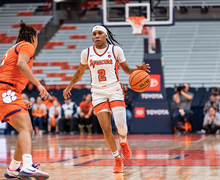Bethel: Trend revealing delay in marriage reflects positive growth of female population
As college students, it is hard to think about and consider what we will be doing 15 years down the road. Though we attend school in order to prepare for the future, we generally live in the present.
However, a growing trend about marriage statistics presents interesting insight into what may affect our future. In short, the younger American generations are waiting longer to marry.
This trend in marriage should be viewed as positive for the overall female population. It shows that despite previous traditions, women are prioritizing their own goals and interests. By waiting longer to marry, women are allowing themselves the freedom to achieve more.
This trend shift shows the drastic change our culture has undergone since the days when our grandmothers and mothers were young. According to a report done by the U.S. Census Bureau in 2012, “since 1970, the median age for women to get married increased by 4.3 years to 25.1 years.”
The statistics are startling and show how women’s roles in society have shifted greatly in the last 40 years. Last year, an article written by ABC News stated that today, women are twice as more likely to go to college than they were 30 years ago. This suggests that women are putting their careers first, and are generally more focused on being financially independent.
These are promising statistics for women in America, who are slowly becoming more and more relevant in the work industry. It also shows that women are more comfortable being alone, and that the stigmas of not marrying early are fading. Marriage is now something to consider and do once all other ambitions, such as an education and steady job, have been met.
For this reason, according to a study done at the National Center for Family and Marriage Research, located at Bowling Green State University, the average age for women to marry is now at 27.
Susan Brown, co-director of NCFMR, wrote that many women are finding themselves in relationships where they enjoy the perks and lifestyle of marriage without actually tying the knot. She says, “Whereas, [marriage] was once largely universal, increasingly couples are content to live together outside of the bounds of legal marriage.”
This demonstrates how the definition of what a relationship should be structured as has changed greatly in the last few decades. For women, independence has become more important than the supposed “reliability” of a man. Also, the defining factors of a relationship have also shifted. Today, gay relationships are more accepted in the public eye than ever in our country’s history.
With Generation Y’s reputation for being more accepting and open minded than its predecessors, it is likely that this trend will continue. Our age group has helped to vote for gay marriage, put a black president in office and has a strong reputation for being environmentally conscious.
We generally do not feel obligated to abide by societal rules if we find they do not properly represent what we believe, and that is why there has been a shift in the average age to marry. Some may reason that the change is strictly due to the increase in women’s education in the last 50 years, however it should be looked at as a shift in state-of-mind.
Throughout the years, the mindset of a happy life has been reestablished to include more than a one-way scenario — people are now more open and tolerant about aspects of our society, such as marriage, that were once not seen that way.
Regardless of the reasoning behind the growing trend, the notion that women are becoming more comfortable with not rushing into marriage is a highlight for the female population. Although being unmarried or divorcing were taboo labels in the past, today they are accepted norms.
Paris Bethel is a junior advertising major. Her column appears weekly. She can be reached at [email protected].
Published on October 26, 2013 at 10:53 pm




